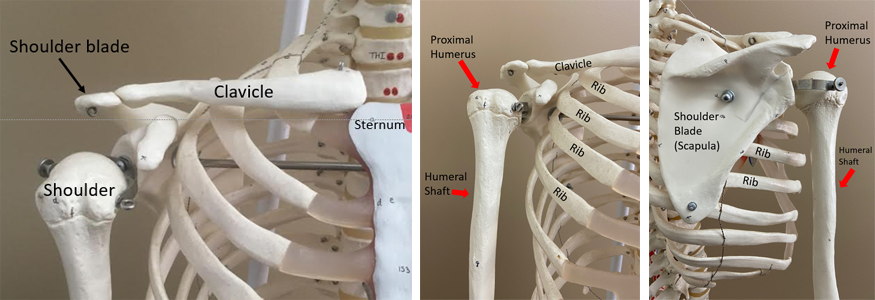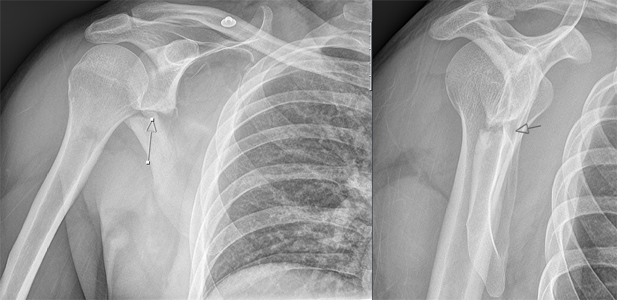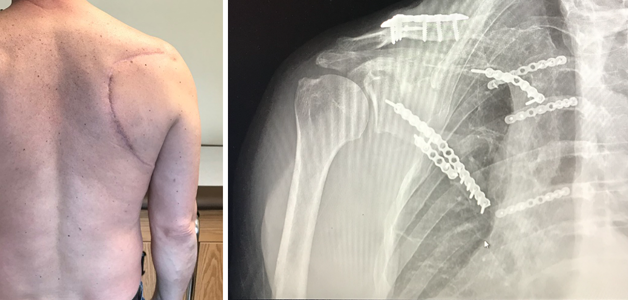Basic Anatomy
The shoulder blade (scapula) is a large, flat, triangular bone that connects the arm bones to the spine and rib cage (Fig. 1). The shoulder joint is made up of the shoulder socket (glenoid of the scapula) and the humeral head at the top of your humerus bone. The scapula attaches to many muscles, and moves on the chest wall to help position your arm. Large blood vessels and nerves travel in front of the shoulder blade and under the clavicle (collar bone). Other parts of the bone include the acromion, which attaches to the clavicle or collar bone, the coracoid process, which attaches to several muscles and ligaments, and the scapular body, which is the largest portion of the shoulder blade (Fig. 2).


Mechanism and Epidemiology
Fractures of the scapula are rare. They typically occur in young male patients, and usually happen due to high energy trauma such as car crashes or a fall. If you have a broken shoulder blade, you may also have other injuries like broken ribs, a broken collar bone, or other broken bones. The shoulder blade often breaks through the very thin part of the bone. This thin part is usually held in place by several muscles and often does not need surgery. The thicker parts like the glenoid (shoulder socket), acromion, or coracoid process are rarely broken (Fig. 3). Fractures of the glenoid can happen with a dislocation of the shoulder joint.

Initial Treatment
Scapula fractures can be very painful in the shoulder, chest, or back. It typically hurts more with breathing or movement of the arm. The shoulder blade is often very tender, and may seem like general pain on the back of your chest. You may also have a lot of swelling around the shoulder. Your doctor will usually order both x-rays and a computed tomography (CT) scan to best view which part of the scapula is broken. Patients do not usually need to be admitted to the hospital for a simple scapula fracture, but you may require a hospital stay if you have other injuries. Scapula injuries can usually be treated with a sling and limited usage till the pain decreases. If you are not admitted to the hospital, you should make an appointment with a doctor soon after the injury.
General Treatment
Most scapula fractures can be treated without surgery. Even after a fracture, most of the thin portion of the bone (scapular body) is held in place by soft tissue. The broken bone will usually heal within 6 to 8 weeks, and your pain will get better over the first few weeks. Moving the arm is encouraged to prevent stiffness. This becomes much easier around 1-3 weeks after your injury. Some scapula fractures may need surgery, especially those that involve the shoulder socket (glenoid), or those with a large amount of displacement. If surgery is performed, a cut is made over the back of the shoulder blade, and plates and screws are used to fix the bones in their correct position (Fig. 4).

Post-Injury / Post-Operative Care
While your broken bone is healing (usually for 6 to 8 weeks), it may be hard to move your shoulder. Your surgeon may limit your arm usage. A combination of pain medication, rest, and ice therapy are often used for pain control. You may use the sling for comfort if needed, but you should take the sling off to move the wrist and elbow to prevent stiffness. Your surgeon will let you know how much you can move your shoulder. If you have weakness or stiffness, you may also need physical therapy. It may take a long time to get recover your movement in your shoulder.
Long Term
Most fractures of the scapula heal without complication. Even if the bones heal in a different position, full shoulder strength and motion can be obtained (Fig. 5). You may feel that the injured shoulder gets more tired or stiff after the injury. Even after healing, the shoulder blade may look different compared to the other side when viewed from behind. If the broken bone involves the shoulder joint, there is a risk of developing arthritis even if you have surgery to fix the bone. If your shoulder dislocated during the initial injury, you may be at further risk for more dislocations, and you may require additional surgery on the surrounding soft tissues. If surgery is done, the plate and screws do not need to be removed unless they bother you.

More Information
---
Tyler Moon, MD and George Ochenjele, MD
Edited by the OTA Patient Education Committee
X-rays and images from the personal collection of Ed Harvey, MD and Chris Domes, MD
